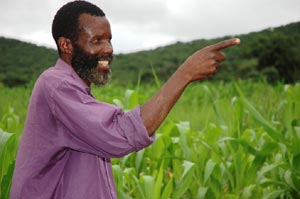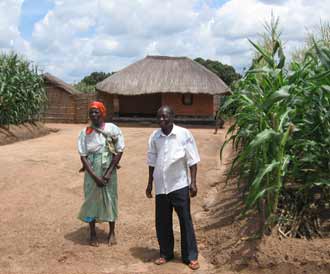CIMMYT E-News, vol 4 no. 2, February 2007
 Farmer Hendrixious Zvamarima, of Shamva village, in Mashonaland Central Province, Zimbabwe, saw a neighbor who, instead of cultivating the soil, sowed his maize seed directly into unplowed soil and residues from last year’s crop. “I was wasting my time using the plow,” says Zvamarima, “so I decided to try the new methods.”
Farmer Hendrixious Zvamarima, of Shamva village, in Mashonaland Central Province, Zimbabwe, saw a neighbor who, instead of cultivating the soil, sowed his maize seed directly into unplowed soil and residues from last year’s crop. “I was wasting my time using the plow,” says Zvamarima, “so I decided to try the new methods.”
Several of Zvamarima’s neighbors had been taking part for as long as three years in demonstrations organized by CIMMYT, Zimbabwe’s Department of Agricultural Research and Extension (AREX), and local organizations like Development Aid from People to People (DAPP). Not wanting to be left out, Zvamarima set up his own “trials” comparing the effects of direct seeding, use of a rip tine to sow and, as a control, conventional plowing. Copying the approach of a university student who visits the area, he took detailed information on all the treatments and, above all, how much labor each entailed. When research team members recently came to Shamva to check progress on the “official” trials, Zvamarima proudly presented his experiment and the fine crop he obtained using direct seeding , keeping crop residues on the surface. As a bonus, it cost him less. “I really liked the labor savings,” he says.
More free time, less drudgery
 |
| Signs of farmer interest and adoption in Malawi In Malawi, CIMMYT has been working with partners (the Department of Agricultural Research & Technical Services; the non-government organizations Total Land Care and the Livingstonia Synod, Soil Fertility Programme) at seven locations throughout the country, and results are encouraging, according to CIMMYT’s Mirjam Pulleman, a CIMMYT soil scientist who studies the soil quality effects of conservation agriculture in Mexico and Africa and recently visited Malawi: “In central Malawi, for example, we saw that the trials looked good and asked the extension workers if there was any adoption, and they said ‘yes!’ and took us on a tour. Every hundred meters or so there was a field where a farmer had followed conservation agriculture practices.” Referring to conservation agriculture practices he has tested, farmer Thompson Kazambe, of Nkhotakota village, said that: “If this technology came 50 years ago, Malawi would be somewhere else!” |
With funding from the Rockefeller Foundation, the Water and Food Challenge Program and Germany’s Ministry for Economic Cooperation and Development (BMZ), CIMMYT and partners have been testing practices in line with the principles of conservation agriculture—in essence, eliminating plowing and keeping residues on the soil surface. Activities in sub-Saharan Africa focus on Malawi, Tanzania, Zambia, and Zimbabwe; countries where small-scale, maize-based farming systems provide food and livelihoods for millions but, year by year, expose soils to severe erosion, degrade soil structure and extract more nutrients than they put back.
Conservation agriculture practices can address these concerns over the medium-to-long term, but the big selling point for most southern African farmers is the dramatic savings in labor and time, which they can then allocate to cash crops, off-farm employment, or other activities.
Other near-term benefits include erosion control and moisture retention: crop residues protect the soil surface from rain and sun; raindrops break down soil crumbs, which blocks pores, and the sun evaporates soil moisture. In a region where periodic, severe droughts can wilt maize plants and bring starvation, crops benefit from more water entering the soil through the pores and less being lost to evaporation.
Will cattle eat what conservation needs?
Challenges to widespread adoption of conservation agriculture in sub-Saharan Africa are many. In most places there is competition for residues: farmers typically feed maize stalks and husks to cattle or other farm animals. Zero-tillage systems also require careful weed control. Herbicides can play an important role, especially during the first few seasons, according to Christian Thierfelder, a postdoctoral fellow from the University of Hohenheim, Germany, seconded to CIMMYT in southern Africa. “But many farmers can’t afford or obtain inputs like herbicides, and they also need the right equipment and knowledge to apply them.”
The bottom line: Sustainable farming systems
In answer to the challenges, Pat Wall, CIMMYT agronomist in southern Africa and leader of the Center’s conservation agriculture work there, points out that smallholder maize systems in the region are currently extractive and unsustainable: “This means working with farmers, researchers, and extension agents to find ways to put the basic principles of conservation agriculture into practice in the community. It also means using our limited resources to catalyze activities among a wide range of stakeholders and partners.”
One such valued partner in the Zimuto Communal Area, southern Zimbabwe, is AREX extension supervisor Monica Runyowa, who serves 6,000 farm households. “The conservation agriculture project has been very useful, especially these on-farm trials. Rather than just telling farmers what to do, we let them try it, and the take-up has been much better.” Zimuto soils are poor and rainfall patchy. “This site has only had 150 millimeters of rainfall so far,” Runyowa says, pointing to nearly knee-high maize plants in a Zimuto field. “You can see that, on the plots with residues and direct seeding, crop germination was quite okay. On the plots sown with farmers’ traditional practice of ox-drawn moldboard plowing and hand seeding, crop establishment is not so good.”
For more information: Pat Wall, CIMMYT Agronomist, Zimbabwe (p.wall@cgiar.org).
 Climate adaptation and mitigation
Climate adaptation and mitigation